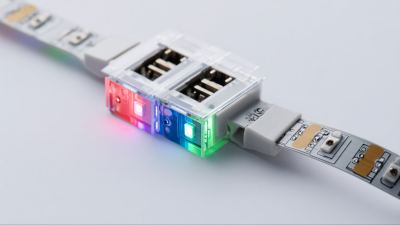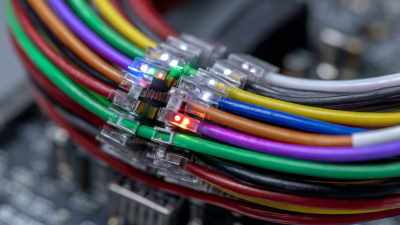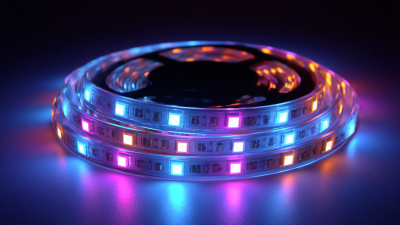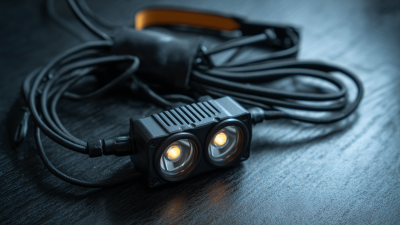Challenges Faced with Custom LED Lights in Modern Applications
In recent years, the demand for custom LED lights has surged, driven by their versatility and energy efficiency. According to a report by MarketsandMarkets, the global LED lighting market is projected to grow from $80.5 billion in 2020 to $127.4 billion by 2026, at a CAGR of 8.3%. This growth reflects an increasing reliance on tailored lighting solutions across various sectors, including commercial, residential, and industrial applications.

However, the implementation of custom LED lights is not without its challenges. Manufacturers face hurdles such as ensuring consistent quality, integrating advanced technologies, and navigating regulatory standards while meeting client specifications. As industries strive for innovative lighting designs that enhance functionality and aesthetics, understanding these challenges becomes crucial for successful deployment and customer satisfaction.
Understanding the Technical Challenges of Designing Custom LED Lights for Specific Applications
Designing custom LED lights presents numerous technical challenges that can significantly affect the end product's performance and efficiency. According to a report from the International Energy Agency (IEA), LEDs reduce energy consumption by about 75% compared to traditional lighting solutions, yet tailoring these lights for specific applications can complicate implementation. Factors like heat dissipation, color rendering index (CRI), and beam angle must be meticulously designed to meet the specific demands of industries ranging from automotive to commercial spaces.
One of the most prominent challenges is ensuring optimal thermal management. Inefficient heat dissipation can lead to reduced lifespan and performance, which is crucial since the average lifespan of an LED is around 15,000 hours under ideal conditions. Moreover, a study by the Lighting Research Center emphasizes the importance of CRI in applications such as retail, where the quality of light significantly influences consumer behavior. Customizing the spectral distribution of LED lights while maintaining efficacy poses a significant hurdle for designers, requiring advanced simulation tools and materials science advancements to overcome these technical barriers effectively.
Challenges Faced with Custom LED Lights in Modern Applications
Examining Cost Factors: Budget Constraints in the Custom LED Lighting Sector
In the evolving landscape of custom LED lighting, budget constraints significantly impact the development and implementation of innovative solutions. As businesses seek to adopt energy-efficient lighting, the initial costs associated with custom designs can be daunting. These costs include not only the materials and technology but also the design, engineering, and installation processes that are unique to specific applications. Many companies struggle to balance the need for high-quality lighting with their financial limitations, which can lead to compromises in design quality or functionality.

Moreover, fluctuating prices of raw materials further complicate budget considerations in the custom LED lighting sector. Manufacturers face challenges in sourcing components while keeping production costs manageable, prompting many to adopt a more conservative approach to custom projects. As a result, the pressure to deliver cost-effective solutions often stifles creativity and limits the exploration of cutting-edge technologies. Businesses must weigh the long-term benefits of custom LED systems, such as energy savings and enhanced performance, against the immediate financial implications, making it essential to find a sustainable approach that allows for innovation within budget constraints.
Addressing Performance Issues: Efficiency and Longevity of Custom LED Solutions
The evolution of custom LED lights has brought about significant advancements in various applications, yet challenges remain, particularly regarding performance and longevity. One primary issue is efficiency. Many custom LED solutions struggle to achieve optimal brightness while consuming minimal energy. This not only affects the operational costs but also the overall sustainability of the lighting systems. Manufacturers are increasingly focusing on the development of advanced drivers and heat management technologies to enhance efficacy, enabling LEDs to produce more lumens per watt without compromising on quality.
Longevity is another critical challenge faced by custom LED applications. While LEDs are known for their extended lifespan compared to traditional lighting solutions, the quality of materials and design can greatly influence their durability. Poor thermal management or substandard components can lead to premature failure, limiting the expected lifespan. Therefore, investing in high-quality materials and rigorous testing processes is essential for ensuring that custom LED solutions not only meet the performance standards but also provide reliable and long-lasting lighting solutions for their intended applications.
Challenges Faced with Custom LED Lights in Modern Applications - Addressing Performance Issues: Efficiency and Longevity of Custom LED Solutions
| Challenge | Description | Impact on Performance | Possible Solutions |
|---|---|---|---|
| Heat Management | Excessive heat can lead to reduced efficiency and shorter lifespan of LED lights. | Decreased lumen output, increased failure rates. | Improved heat sinks, active cooling solutions. |
| Color Consistency | Variations in LED colors can affect appearance and user satisfaction. | Lower quality perception, inconsistency in lighting design. | Strict quality control, binning processes. |
| Flicker | Poor driver design may cause undesirable flicker, impacting user comfort. | Eye strain, decreased user acceptance. | Use of high-quality drivers and capacitors. |
| Energy Efficiency | Balancing brightness with energy consumption can be challenging. | Increased operational costs, environmental impact. | Adopting advanced technology and materials for improved efficiency. |
| Longevity | Deterioration over time can lead to reduced performance and light output. | Increased replacements, lower customer satisfaction. | Use of high-quality materials and components. |
Regulatory Compliance: Navigating Standards and Certifications in Custom LED Lighting
Navigating the complexities of regulatory compliance in custom LED lighting can be a daunting challenge for manufacturers and designers. With various standards and certifications at play, such as the Energy Star program and RoHS directives, ensuring that products meet these requirements is crucial for market entry and consumer safety. Each region may have its own set of regulations, making it essential for companies to stay updated on the latest compliance mandates relevant to their target markets.
**Tip:** One effective approach to streamline compliance is to engage with regulatory experts early in the design process. This can help identify potential compliance issues before they arise, saving time and resources in the long run.
Furthermore, understanding certification processes such as UL or CE marking can significantly impact your product's credibility. These certifications not only enhance your product’s marketability but also reassure customers about safety and environmental considerations. By investing time in the certification process, companies can enhance their brand reputation and customer trust.
**Tip:** Consider integrating compliance metrics into your project management tools to keep track of regulatory requirements throughout the product development cycle. This proactive measure can help ensure that your custom LED lights remain compliant from conception to market launch.
Innovation Roadblocks: Overcoming R&D Challenges in Custom LED Lighting Design
As the demand for custom LED lighting solutions surges across various sectors, R&D teams face significant innovation roadblocks. A study by MarketsandMarkets predicts that the global LED lighting market will reach $105.7 billion by 2025, reflecting a CAGR of 13.6%. This growing market presents unique challenges, including the need for tailored designs that meet specific performance and aesthetic requirements. One major obstacle is the rapid pace of technological advancement; R&D teams must continuously adapt to new materials and technologies, which can result in resource allocation issues.
To navigate these challenges effectively, companies should prioritize agile methodologies in their R&D processes. This approach allows teams to iterate quickly, integrating customer feedback and mitigating risks associated with new technology implementations. Furthermore, investing in simulation software can streamline the design process, reducing time-to-market and costs associated with prototyping.
Another key tip for overcoming R&D hurdles is fostering collaboration between interdisciplinary teams. Engaging engineers, designers, and marketing professionals early in the development process can lead to innovative solutions that are not only technically feasible but also commercially viable. A collaborative environment encourages creativity and inspires new ideas that can push the boundaries of custom LED lighting design.

Related Posts
-

Exploring Unique Alternatives to Traditional LED Wiring Harness Solutions
-

How to Choose the Best LED Strip Connector for Your Lighting Projects
-

Unlocking the Technical Specifications of the Best LED Light Wiring Harness for Global Buyers
-

The Ultimate Guide to Choosing the Perfect LED Strip for Your Project
-

How to Choose the Right LED Light Wiring Harness for Your Projects
-

How to Choose the Best LED Light Harness for Optimal Performance and Efficiency
